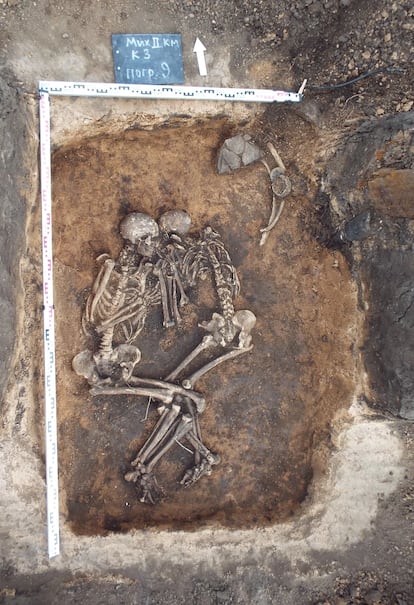What a 3,000-year-old body reveals about the origins of the worst pandemic in history
New research has identified the oldest case of the bubonic plague in Western Europe, a finding that sheds light on the genetic evolution of the pathogen

The oldest case of the bubonic plague in Western Europe has been identified in a body buried more than 3,300 years ago in Spain’s Basque Country. The man’s skeleton was found in Álava province in a dolmen called El Sotillo. The family tomb also held the remains of 12 other people, as well as a large assortment of burial offerings including arrowheads, knives and metal axes and 1,000-year-old stone carvings. The finding raises many questions about the origins of a disease that would go on to cause the worst pandemic in history.
According to a genetic analysis of a tooth from the body, the variant of the plague that killed the victim had already developed the ability to infect fleas. The Yersinia pestis bacterium forms a kind of ball in the mouth of the stomach of the flea, which feeds on the blood of animals and humans. This bacterial ball causes the flea to vomit up blood, which is infectious to any other organism that touches it. Instead of biting its host a few times to satiate itself, the flea bites hundreds of times because it’s crazed with hunger. It thus becomes a tiny propagator of the plague bacteria, one that is capable of traveling hundreds or even thousands of miles.
“It’s a brilliant adaptation,” sums up Aida Andrades Valtueña, a 30-year-old geneticist from Barcelona and the lead author of the study that will be published this week in the Proceedings of the National Academy of Sciences (PNAS). “The disease can be transmitted with a few bacteria, but the more bites the flea makes, the greater its ability to spread,” she highlights. In humans, the plague bacteria accumulate in the lymph nodes, which swell to the point of deformity. Within 10 days, the pathogen has conquered the entire body and produces fatal septicemia.
The study analyzed the genome of 252 individuals who lived between 5,000 and 2,000 years ago, including 17 who were killed by the plague. Researchers have compared bacteria from this time with bacteria from the worst known plague pandemics, including the Justinianic Plague in the 6th century and the Black Death in the 14th century, which killed one in three Europeans. “It is the most complete set of cases that has been gathered to date,” says Andrades, who works at the Max Planck Institute for Evolutionary Anthropology, in Germany.
Only two other deaths from the bubonic plague have been identified from this time: a man and a woman, aged around 35, who were buried huddled together facing each other with clasped hands 3,800 years ago.

These bodies were found in the Russian region of Samara, which is more than 3,100 miles (5,000 kilometers) from the dolmen in Álava. But in both cases, the pathogen already had the genetic adaptations necessary to cause the bubonic plague, in particular the ymt gene that allows Yersinia pestis to colonize fleas. From a genetic point of view, the bacterium found in El Sotillo is evolutionarily older than the Russian one, so there is a possibility that the bubonic plague could have originated in the Iberian peninsula and not in Eurasia, as previously thought.
The study also reveals several cases of another variant that was not yet capable of infecting fleas and that did not have all the virulence genes. “This other plague is a mystery,” acknowledges Carles Lalueza-Fox, co-author of the study and a geneticist from Spain’s national research center CSIC. “We don’t know where it came from, how it was transmitted, or how serious it was. The most surprising thing is that we showed that this variant coexisted with the bubonic for about 2,000 years until it disappeared, so it had to be successful in evolutionary terms,” he says.
About 5,000 years ago, a civilization of nomadic herders from the steppes of Eurasia known as the Yamnaya culture spread to Western Europe, leaving their genetic mark wherever they went and erasing that of the local community. The consequences of that episode persist today – most Europeans carry a large part of Yamnaya genes in their genome. It was just at this time that Europe’s population fell sharply. It is not clear whether this was due to a violent invasion or the repopulation of settlements that were burned for unknown reasons. One of the biggest unknowns raised by this study is whether those migrants brought the plague with them.
“It’s a very difficult question to answer,” admits Lalueza. “The man from El Sotillo dolmen already has the genetic mark of the Yamnaya. But it is possible that the plague arrived before these migrants through commerce and communication routes. It is something that also happened with the diseases that came to America with the Spanish conquistadors. Sometimes entire towns died of measles or other diseases of European origin,” he explains, adding that these diseases often reached the towns before the Spaniards due to the movement of the local population.
The results of the work illustrate how the pathogen changed during the 2,000 years that the two plagues coexisted. “We see that it loses some genes and it is possible that it is because it had already developed the ability to infect fleas, and thanks to this, it could spread easily, whereas before it needed to maintain the ability to infect other species,” explains Andrades.
It is very likely that this other already-extinct plague infected animals first and then humans, as is the case with many other pandemics, including the current coronavirus, which likely originated in bats. “Goats and sheep suffer from the plague, but often, they don’t die from it, and sometimes they don’t even develop symptoms. It is also possible that it was the horses that carried the pathogen or even that the first contagions were from eating infected animals. One of the latest cases of bubonic plague that have been registered, in 2020, was due to the human consumption of viscera from an infected marmot,” she says.
Three years ago, Argentine biologist Nicolás Rascován and his team found the body of a girl who had been killed by the plague in what is now Sweden. It happened about 5,000 years ago, and the Yersinia pestis bacteria that killed her predates the two variants analyzed in this study. “The most significant thing about this new work is that it shows us that the plague lineage that was not transmitted by fleas was widespread throughout Eurasia,” says Rascován, who works at the Pasteur Institute in Paris. “The only other pathogen that has been identified in that era is hepatitis B, which was not fatal. On the other hand, I believe that the plague that has disappeared today must have been very infectious and deadly; it probably caused the first great pandemic in history. You have to remember that the plague bacteria settles mainly in the intestines and blood. The old samples analyzed here are from the teeth, which implies levels of bacteria in the blood that are not really compatible with a mild disease,” he explains.
The researcher also believes that there is a clear link between the arrival of the Yamnaya culture and the plague. “Plague cases are higher, the greater the genetic contribution of the Yamnaya,” he says. Another unanswered question is what is the origin of the most primitive forms of plague. For now, the oldest cases are in Europe, but it is possible that back then the bacterium was also present in China and other Asian countries. The researchers believe that this matter can only be resolved by the appearance of new genetic data from this region.
Tu suscripción se está usando en otro dispositivo
¿Quieres añadir otro usuario a tu suscripción?
Si continúas leyendo en este dispositivo, no se podrá leer en el otro.
FlechaTu suscripción se está usando en otro dispositivo y solo puedes acceder a EL PAÍS desde un dispositivo a la vez.
Si quieres compartir tu cuenta, cambia tu suscripción a la modalidad Premium, así podrás añadir otro usuario. Cada uno accederá con su propia cuenta de email, lo que os permitirá personalizar vuestra experiencia en EL PAÍS.
¿Tienes una suscripción de empresa? Accede aquí para contratar más cuentas.
En el caso de no saber quién está usando tu cuenta, te recomendamos cambiar tu contraseña aquí.
Si decides continuar compartiendo tu cuenta, este mensaje se mostrará en tu dispositivo y en el de la otra persona que está usando tu cuenta de forma indefinida, afectando a tu experiencia de lectura. Puedes consultar aquí los términos y condiciones de la suscripción digital.
More information
Últimas noticias
The metaverse, four years later: Is it finished or just at a standstill?
$3,000 and a plane ticket: The United States increases incentives for migrants to self-deport before the end of the year
Charles Dubouloz, mountaineering star, retires at 36 with a farewell tour inspired by Walter Bonatti
From the White House to diplomatic gifts: Lego wins over adult fans, brick by brick
Most viewed
- Families demand repatriation of bodies of Colombians who died in Ukraine: ‘This war is a slaughterhouse for foreigners’
- The low-cost creative revolution: How technology is making art accessible to everyone
- Liset Menéndez de la Prida, neuroscientist: ‘It’s not normal to constantly seek pleasure; it’s important to be bored, to be calm’
- Christian Louboutin: ‘Young people don’t want to be like their parents. And if their parents wear sneakers, they’re going to look for something else’
- Christmas loses its festive spirit: ICE fears cast shadow over religious celebrations











































